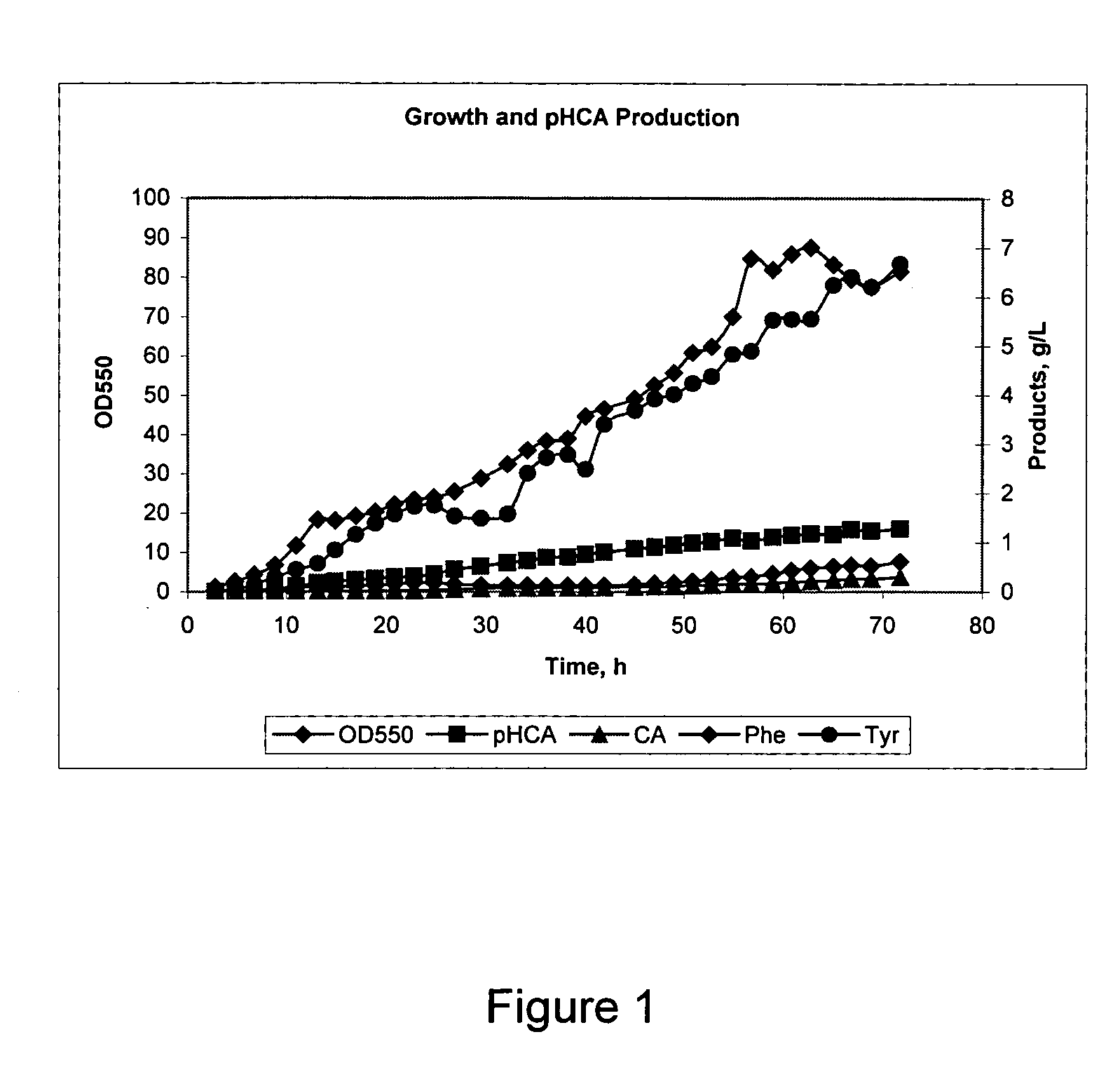Methods for the preparation of para-hydroxycinnamic acid and cinnamic acid at alkaline PH
- Summary
- Abstract
- Description
- Claims
- Application Information
AI Technical Summary
Problems solved by technology
Method used
Image
Examples
examples
[0124] The present invention is further defined in the following Examples. It should be understood that these Examples, while indicating preferred embodiments of the invention, are given by way of illustration only. From the above discussion and these Examples, one skilled in the art can ascertain the essential characteristics of this invention, and without departing from the spirit and scope thereof, can make various changes and modifications of the invention to adapt it to various uses and conditions.
[0125] The meaning of abbreviations used is as follows: “min” means minute(s), “h” means hour(s), “sec” means second(s), “rpm” means revolutions per minute, “μL” means microliter(s), “mL” means milliliter(s), “L” means liter(s), “nm” means nanometer(s), “mm” means millimeter(s), “cm” means centimeter(s), “μm” means micrometer(s), “mM” means millimolar, “M” means molar, “mmol” means millimole(s), “μmol” means micromole(s), “g” means gram(s), “μg” means microgram(s), “mg” means milligr...
examples 1-12
The Effect of pH on the Production of pHCA in Two-Stage Fermentations
[0155] The purpose of these Examples was to demonstrate the effect of increasing the pH during fermentation on the production of pHCA by various recombinant strains. In these Examples the fermentation was carried out at an initial pH of 6.5 to 7.0 and the pH was changed at a time during the fermentation to a pH from 6.1 to 9.7.
[0156] The strains used in these Examples were E. coli DPD5013, E. coli DPD4512, and E. coli DPD5040, constructed as described above. These strains are recombinant E. coli strains that were designed for overproduction of tyrosine and conversion of the tyrosine produced to pHCA by the inclusion of the pal gene from R. glutinis. Phenylalanine was produced as a side product in these runs and was converted to CA by the PAL activity.
Fermentation Protocol:
[0157] The pre-seed culture was a frozen culture of the desired recombinant E. coli strain. The seed culture was grown for approximately 15 ...
examples 13-17
Effect of pH on the Biocatalytic Conversion of Tyrosine to pHCA (Study #FL-2003-16)
[0163] The purpose of these Examples was to demonstrate the effect of pH on the biocatalytic conversion of tyrosine to pHCA using recombinant E. coli strains containing a TAL enzyme activity. The protocols used to produce cultures having TAL activity were described in Examples 1-12.
[0164] Samples of cell culture broth (10 mL portions) from Example 8 containing E. coli strain PD4512 was distributed into 125 mL baffled flasks, L-Tyr was added to a concentration of 10 g / L, and the pH of was adjusted to various values with concentrated KOH or H2SO4.
[0165] The flasks were incubated in an incubator shaker (Innova 4000, New Brunswick Co.) at 35° C. and 300 rpm. At various times, samples were taken and analyzed for pHCA using HPLC, as described above. The pH conditions and the concentration of pHCA produced are summarized in Table 3 (Reference No. FL-2003-16).
TABLE 3Effect of pH on the Biocatalytic Conve...
PUM
| Property | Measurement | Unit |
|---|---|---|
| Temperature | aaaaa | aaaaa |
| Temperature | aaaaa | aaaaa |
| Molar density | aaaaa | aaaaa |
Abstract
Description
Claims
Application Information
 Login to View More
Login to View More - R&D
- Intellectual Property
- Life Sciences
- Materials
- Tech Scout
- Unparalleled Data Quality
- Higher Quality Content
- 60% Fewer Hallucinations
Browse by: Latest US Patents, China's latest patents, Technical Efficacy Thesaurus, Application Domain, Technology Topic, Popular Technical Reports.
© 2025 PatSnap. All rights reserved.Legal|Privacy policy|Modern Slavery Act Transparency Statement|Sitemap|About US| Contact US: help@patsnap.com



